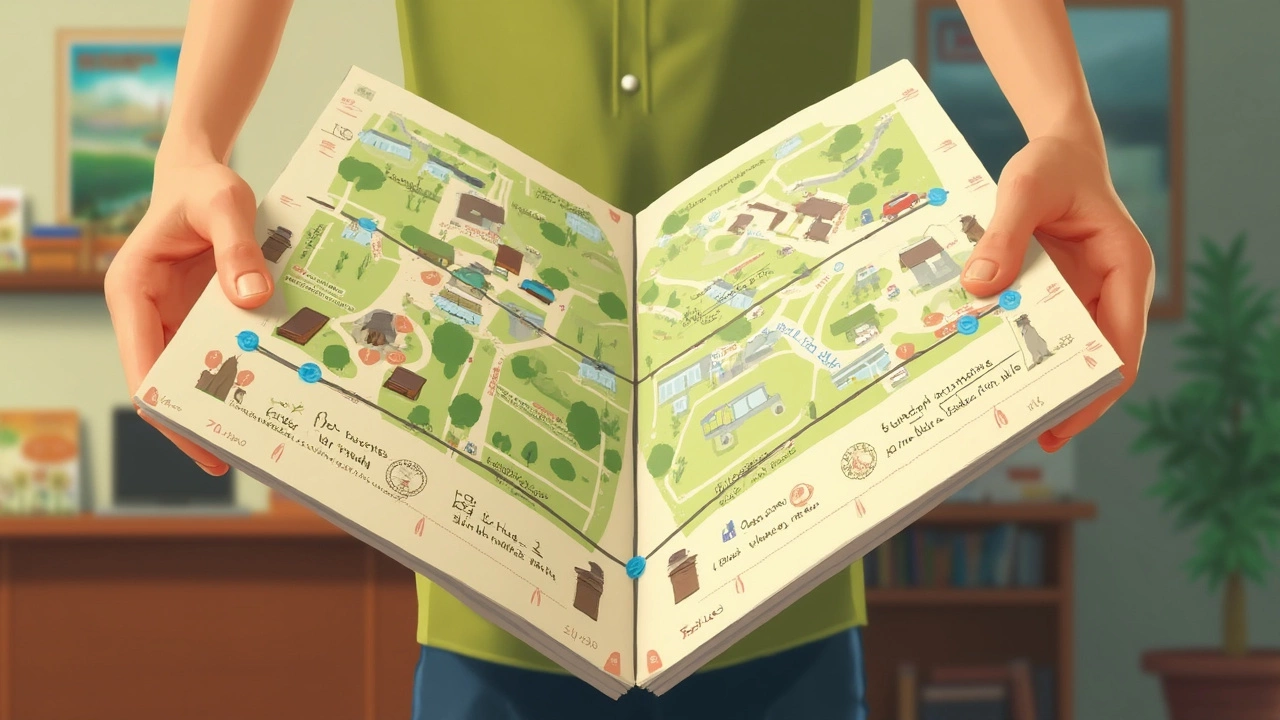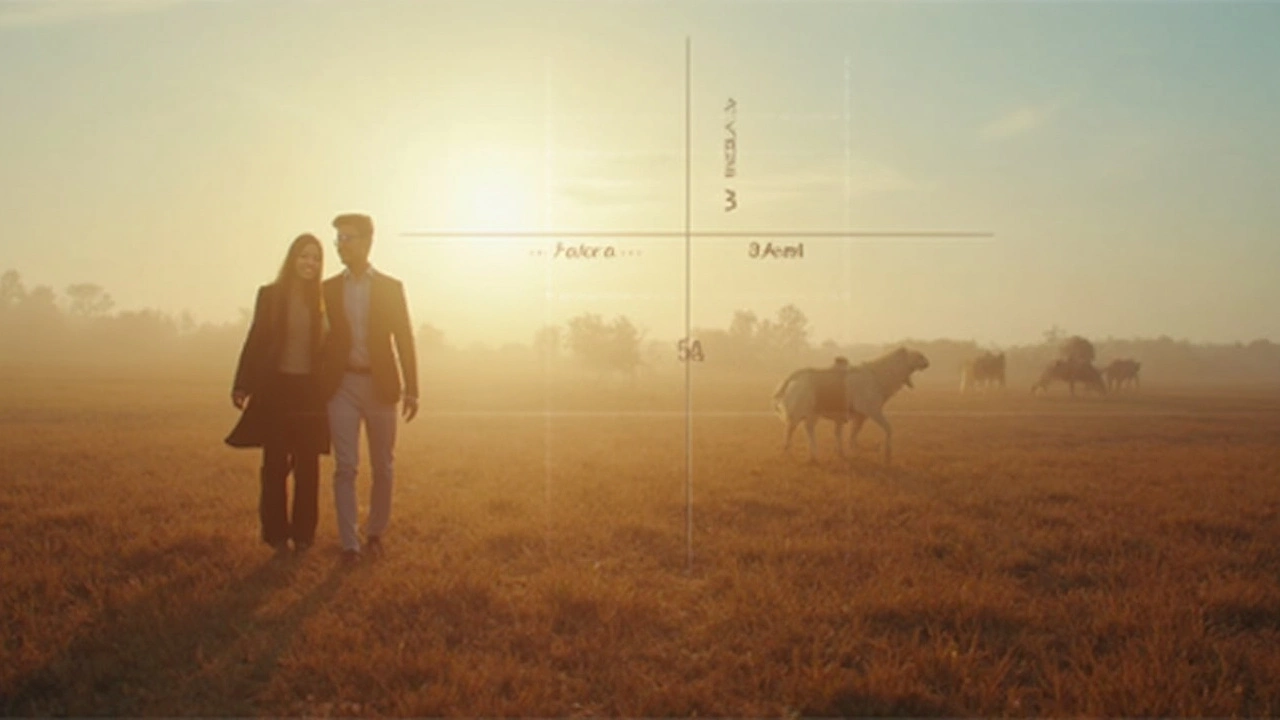The word 'acre' gets thrown around constantly when people talk land for sale, but if you’ve never walked one, it’s tough to picture what it really means. Here’s a stat that might surprise you: an acre isn’t some magic square of land, and it’s definitely not the same as a “city block.” So what’s the real story?
An acre measures 43,560 square feet. But when you try to turn that into a straight line—it isn’t so simple. If you shape one acre as a perfect square, each side is about 208.7 feet long. Want miles? That’s about 0.039 miles on each side. So, an acre is less than 1/20th of a mile long if it’s squared off. Not much, right? But if you walk all the way around the edge, you’d cover over a third of a mile (to be exact: 0.317 miles, if you count all four sides together).
If you stretch an acre into a long rectangle—like a strip along a country road—the sides can get wild. For example, an acre could be 66 feet wide and 660 feet long (people call this a 'chain by a furlong'). Bottom line: an acre can stretch long or squat square, but the area is always locked at 43,560 square feet. Handy if you’re comparing listings or checking if a lot will actually fit what you want to build.
- What Does One Acre Look Like?
- Acre to Mile Conversion (The Easy Way)
- Why Acres Matter in Land Sales
- Tricks for Visualizing Acreage
- Quick Tips When Checking Lot Size
What Does One Acre Look Like?
A lot of people get tripped up trying to picture how big an acre actually is. You hear it all the time in ads for 1 acre in miles, but your brain just blanks on what that means in real life. The truth? One acre is always 43,560 square feet—whether you’ve got a wild, wonky-shaped property or a neat square, that number doesn’t change.
Want something more concrete? Picture a football field, not counting the end zones. That patch of grass is just a bit bigger than an acre. If you remove the end zones, an American football field is 48,000 square feet—pretty close. So one acre almost covers most of that playing surface.
If you like numbers, here's another way to see it: stack about 16 tennis courts side by side, and that’s about an acre. Or maybe you’re into running tracks—a standard running track’s inside area is about 1.3 acres. So, a single acre fits right inside with some room to spare for warming up.
One acre shaped in a perfect square would be roughly 208.7 feet by 208.7 feet. For a quick check, if you pace off 200 steps in each direction, you’re looking at a square about the size of an acre. If you walk all the way around the edge, you’d cover just over a third of a mile.
- Fun tip: If you see a listing for a single-acre lot, try to picture 16 parking lots at your local grocery store all jammed together—that’s about the right size.
- Don’t forget, an acre in real life doesn’t always come in neat shapes, especially when you’re talking country land. Always check the length and width if you can.
Put simply, an acre is bigger than most backyards, smaller than a sports field, and comes in all sorts of shapes once you start looking at real lots for sale.
Acre to Mile Conversion (The Easy Way)
Getting from acres to miles is easier than it sounds—you just have to remember a couple key numbers. There are exactly 5,280 feet in a mile. And, as drilled home before, one acre is always 43,560 square feet. So, how does an acre translate on that mile scale?
If you set a strip of land one mile long and want to know how wide it needs to be to make up one acre, you just divide 43,560 by 5,280. Here’s the math:
- 43,560 ÷ 5,280 = 8.25 feet
That’s right—a strip of land just 8.25 feet wide (imagine the length of a big dining table) and a full mile long is still only one acre. It puts the size of an acre in perspective, doesn’t it?
Flip it around: if you have a square acre, each side is about 208.7 feet. Let’s see what that means in miles:
- 208.7 feet ÷ 5,280 feet per mile ≈ 0.0396 miles
So, one side of a square acre is less than 0.04 miles long. Walk it in a straight line and you barely get your steps in. If you’re comparing lots advertised in miles, it often takes more than 600 acres just to cover one square mile (to be exact, 640 acres = 1 square mile).
Here’s a cheat sheet for when you’re shopping for land:
- 1 acre in miles (one straight line): 0.00156 square miles
- 1 square mile: 640 acres
- 1 acre as a square: sides are roughly 0.04 miles each
If someone says they have “miles” of land, they’re talking serious acreage. Now, if you spot two listings—one in acres and one using miles—you can quickly stack them up side-by-side.

Why Acres Matter in Land Sales
People shopping for land want a solid way to compare lots. That’s where acres step in—they’re the go-to for sizing up property, whether it’s for building, farming, or just a getaway spot. When folks talk about 1 acre in miles, they get a sense of the actual land they’re buying, instead of just looking at a vague map.
Here’s something you might not know: counties, cities, and even banks use acres to figure out things like zoning, buildable area, or what kind of loan you can get. Picture this: when real estate listings pop up, you can skim ten properties fast if you know how much space an acre covers. It’s a universal language that buyers, sellers, and lenders all speak.
If you’re going for residential land, the average single-family home lot in the U.S. is about 0.19 acres—much smaller than a full acre. But for folks looking at ranches or woodlands, many properties might be 5 acres, 10 acres, or more, and those numbers matter for everything from taxes to access to utilities.
| Land Use | Average Acreage | Why It Matters |
|---|---|---|
| Urban home lot | 0.19 acres | Lower property taxes, easier upkeep |
| Rural home lot | 1+ acres | Room for hobbies, more privacy |
| Small farm | 5-40 acres | Qualifies for ag programs, tax breaks |
Having acres as a standard goes beyond buying and selling. It’s used for everything from dividing old family farms to setting city park boundaries. Plus, when you call a surveyor or county office, you’ll hear acres mentioned all the time—it’s just the way business gets done in real estate.
Tip: Double-check if the land still matches the acreage in the listing. Sometimes maps get redrawn or parts are sold off. The latest survey saves you future headaches.
Tricks for Visualizing Acreage
It’s one thing to hear “43,560 square feet” and a whole different story to actually picture it. Most people find it tough to imagine how an acre fits in real life, but there are a few simple tricks that make it a lot clearer.
If you’re standing on a property and want a quick visual: think about an American football field. Not counting the end zones, a full-size football field is about 48,000 square feet. So, one acre is just a tiny bit smaller—think a field with about 10 feet chopped off each end. Baseball fans? A typical Major League field's outfield is also roughly an acre, give or take, depending on the stadium.
For folks used to city lots: if your average suburban yard is about one-fifth of an acre, five of those lots lined up together would about cover it. Walking distance helps too—if you stroll the length of a square acre, you’re covering almost 209 feet each direction. Bust out a pedometer: that's usually well under 100 steps for most adults.
- Picture 16 tennis courts placed together side-by-side—that's one acre.
- Looking at a parking lot? Around 100 average-sized cars can park on an acre, without walkways or landscaping.
- If you like running tracks, an acre is about 60% of the size of a standard 400-meter outdoor track’s infield.
Sometimes it helps to just see the numbers. Here’s a fast comparison table using places we all know:
| Real-world Space | Area (Square Feet) | How it Compares to 1 Acre |
|---|---|---|
| Football Field (no end zones) | 48,000 | A bit bigger |
| Standard Tennis Court | 2,808 | ~16 fit in one acre |
| Average House Lot | 8,712 | ~5 fit in one acre |
| 1-Acre Square (each side) | 208.7 feet | Just under 1/20th of a mile |
Next time you’re out shopping for land, keep these visuals in mind. You’ll spot overstated claims (or weirdly shaped lots) much faster, and you’ll have a way better sense of just how much room you’re actually getting.

Quick Tips When Checking Lot Size
It’s easy to get tripped up by numbers—especially when realtors toss around acreage without much context. Here’s what to do if you want to avoid nasty surprises and make sure the 1 acre in miles actually fits your needs.
- Check the actual shape of the lot. Not all acres are nice squares! Long, narrow lots can be a pain for building. Always ask for a plat map or aerial photo before you commit.
- Measure the boundaries, not just the area. Bring a decent measuring wheel if you’re touring the property yourself, or use the county’s GIS (Geographic Information System) maps online. Google Maps’ measuring tool works in a pinch too.
- Don’t eyeball it. Studies show most folks overestimate large spaces. What looks big on paper might feel tiny when you’re on the ground, especially if there’s steep hills or trees everywhere.
"It's common for buyers to misunderstand land size – an acre can feel bigger or smaller depending on how its boundaries are laid out," says the National Association of Realtors Land Institute.
Want some data to compare? Check out this quick table:
| Lot Shape | Feet on Each Side | Edge Total (Miles) |
|---|---|---|
| Square | 208.7 x 208.7 | 0.317 |
| Traditional Farm Strip | 66 x 660 | 0.305 |
| Long Rectangle | 50 x 871.2 | 0.347 |
If you plan to build, always check with your local zoning office before signing anything. Some places have minimum lot widths, and you’d hate to discover your mile-long, skinny acre is too narrow for a house or driveway.
And before you get excited about a 'one-acre wooded lot,' ask about usable acreage. Creeks, wetlands, or steep slopes often mean less land for your dream project. Setbacks and easements also eat up room, so make sure you have the space you think you’re buying.
Last tip: If you’re ever unsure, hire a land surveyor. Their fee is small compared to the cost of buying land that doesn’t work for you.

